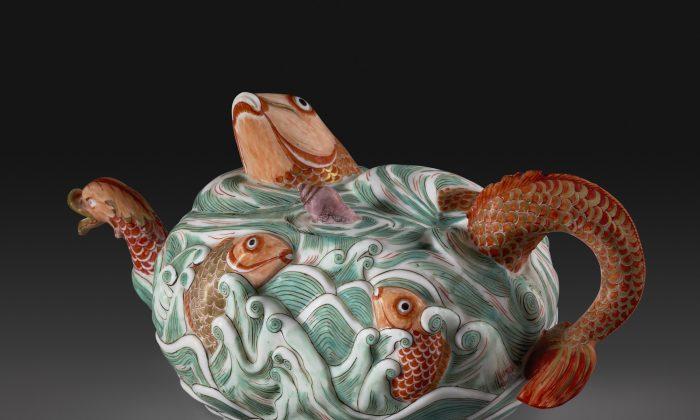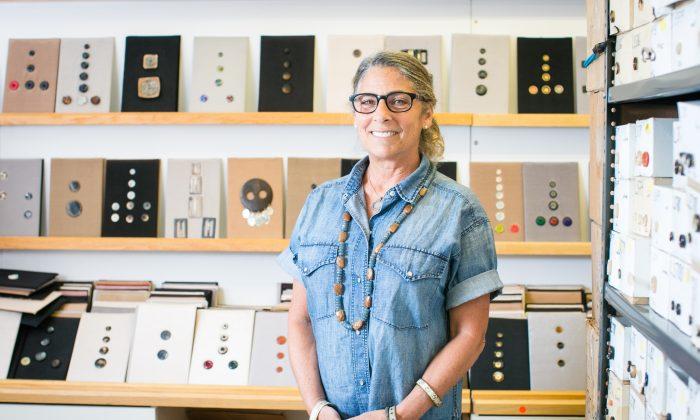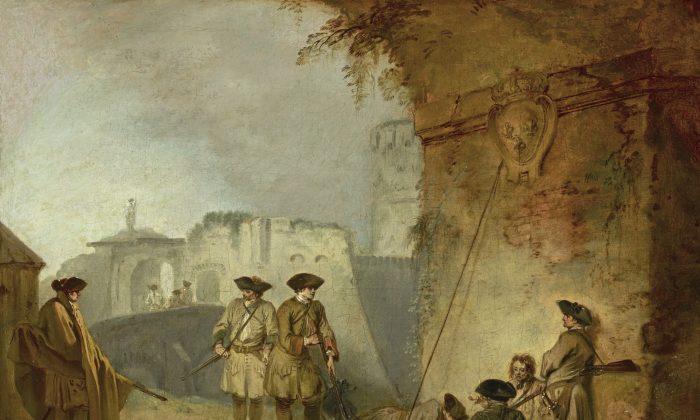NEW YORK—The porcelain mania that gripped Europe prior to 1700 and after 1708, when the Europeans cracked the most closely guarded secret in Chinese decorative arts, has truly subsided. Nowadays, porcelain ware is usually relegated to minor displays in most museum situations, and in households with heirlooms. It is displayed in forbidding glass cabinets in motley collections that rather glorify the gaudy, with pieces that hold purely sentimental value.
The exhibition Porcelain, No Simple Matter: Arlene Shechet and the Arnhold Collection that has recently opened at The Frick, aims to reignite our appreciation for the genre through a new kind of display that holds many surprises.

New York−based sculptor Arlene Shechet selected 130 works from the Henry H. Arnhold collection that were produced from 1720 to 1745 by the renowned Royal Meissen manufactory—the first to produce porcelain ware in Europe. Included are 16 of Shechet’s own sculptures made during a series of residencies at the Meissen manufactory in 2012 and 2013.
The Frick’s Portico Gallery, which overlooks the museum’s historic Fifth Avenue Garden, feels a lot like a small-scale version of the Hall of Mirrors at thePalace of Versailles. In the spirit of rococo style, which sought to emulate the lightness, asymmetry, and abundance of nature, Shechet sought to break the indoor/outdoor separation. Larger works, such as “Bird, Squirrel, and Stag Beetle on a Tree Trunk,” are shown standing free on top of a transparent table containing more delicate utilitarian pieces, or embedded in the lush foliage of the museum’s garden. The outdoor pieces, three birds and the “Nanny-Goat with Kid,” are replicas of Johann Joachim Kändler’s works from 1732.

Displaying Porcelain
For Europeans, porcelain wasn’t something to use as much as something to display—it was the radical art of the time, according to Shechet. The wealthy would make whole displays of it, like paintings on a wall or sculptures.
Prior to 1700, the sought-after pieces were imported from China. In 1708, the Royal Meissen manufactory began producing porcelain pieces, paving the way for Europe to develop its own aesthetics in porcelain.
Once porcelain was produced in greater quantities, the demand for tableware increased, with the first services made in the 1720s.
The first installation as one steps into the Portico Gallery holds one of the little surprises of the exhibition, and registers rather subliminally with a kind of familiar warmth.

Among other pieces both decorative or utilitarian, a gilded “Tea, Coffee, and Chocolate” service is displayed with the cups and saucers stacked up. The gilding on the teapot shows signs of wear in places where the servant who would have touched it most often would have secured it when pouring the hot liquid. One begins to wonder if she or he was left-handed, and whether she or he would have ever enjoyed the precious liquids served in it.
Shechet told the Epoch Times that this type of display would not have been done in a classic Frick or Metropolitan Museum of Art exhibition of 18th century porcelain.
“I stacked the cups, I turned them upside down and used them to put other things on top so that there was a sense of losing the preciousness. I wanted to bring them closer to the human hand—even if people can’t touch, they can see that they’ve been touched,” said Shechet.
European Style
As one moves through the exhibition, what becomes apparent is that in little more than a decade after discovering the formula to manufacture porcelain, European artists who were subsequently employed by the Meissen manufactory, such as Johann Joachim Kändler and Johann Friedrich Eberlin, had reached such creative sophistication that they could go beyond merely replicating Chinese and Japanese motifs, to develop a distinctly European style.

According to Shechet, the artists were very skilled and motivated. Augustus II the Strong, who ruled Poland from 1697 to 1733 and was Elector of Saxony, was loathed as a figurehead, yet he founded the Royal Meissen porcelain manufactory and poured finances into it to fuel his own obsession with “white gold” (as porcelain was called). He had amassed 20,000 pieces of Asian porcelain in his own collection, a ridiculous amount by any standards, and he was on a mission to match the Chinese production.
These early works retain the handmade feel, and a somehow painterly, not-quite-so-perfect flair, which was perhaps the result of the manufactory still working on systematizing its production—something that is most definitely not the case in the way Meissen porcelain ware is produced today.
The “Cruet and Mustard Pot” depicting comical figurines riding multicolored roosters have a distinctly imperfect style. Another piece, the “Small Two-Handled Bowl with Cover” modeled by Johann Joachim Kändler and/or Johann Friedrich Eberlin is pure white with flowers in relief that, in certain places, look as if they barely touch the surface. The gilding inside the lid serves to frame a small bucolic tableau of the local countryside painted in violet underglaze. These works are noteworthy examples of the developing European styles.
During her residency at the Meissen manufactory, Shechet noted the production process is so rigidly segmented that everybody has one single job in which he or she excels.
“They only do one tiny bit—they might paint one kind of shape, they have people who just sign the crossed swords of the Meissen emblem. They were fascinated with the fact that I was interested in doing the whole process,” she said.
Her dragon dish is in direct reference with the Meissen dragon plate, in underglaze red with gilt details, which is also part of the exhibition.
“I took it three steps further—I made it much larger and much funnier,” said Shechet.

Another of her works, the “Scallop Bowl,” is a porcelain version of the actual mold used at Meissen to cast its “Fluted Bowl.” The two works are paired together.
Shechet hopes that visitors will relish the opportunity to discover the artistry involved in creating the works on show, be they for display or utilitarian purposes.
“I want there to be a sense of humor and seriousness, enjoyment and intellectual contemplation. I also want people to be surprised—maybe more than anything,” said Shechet.






